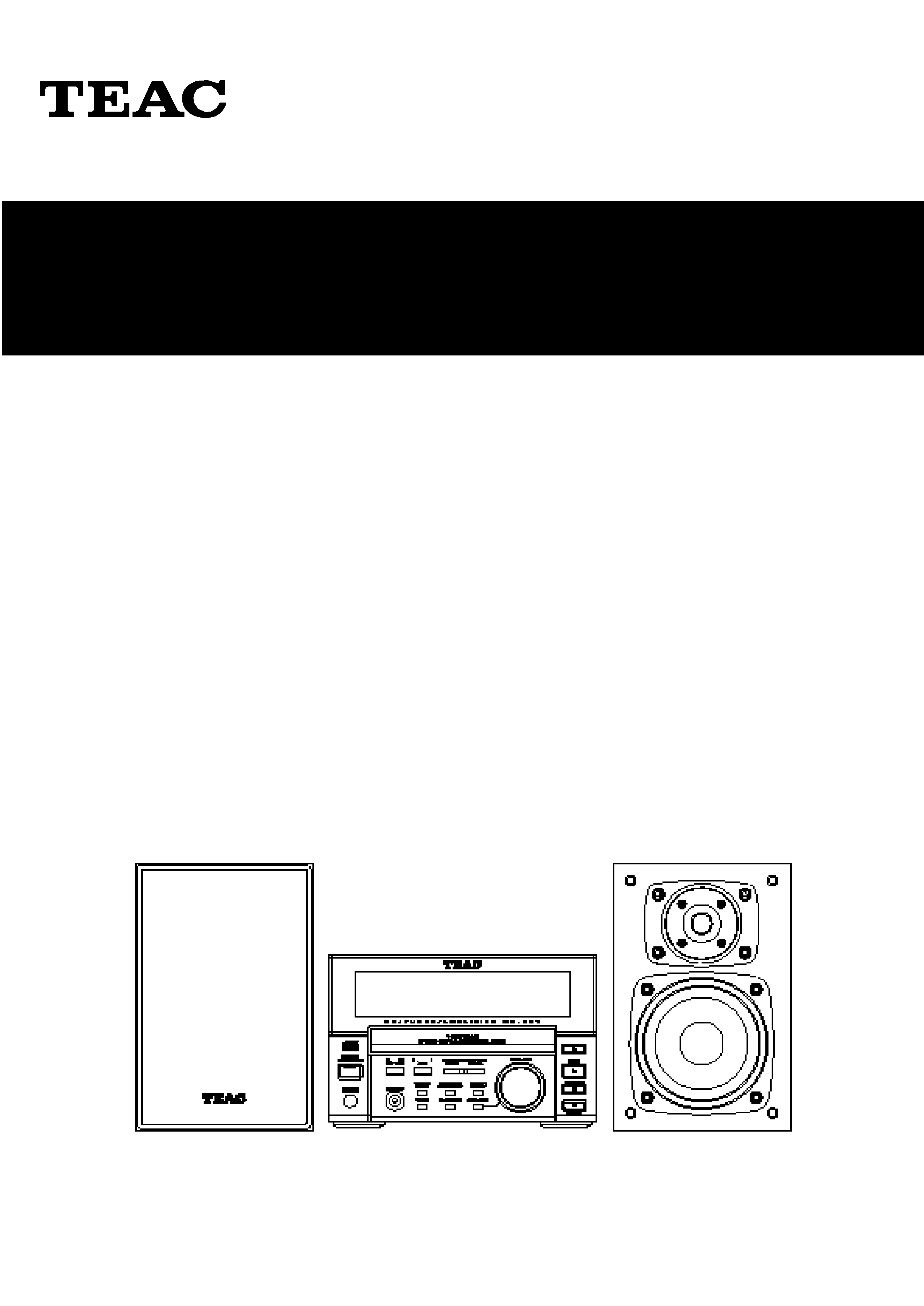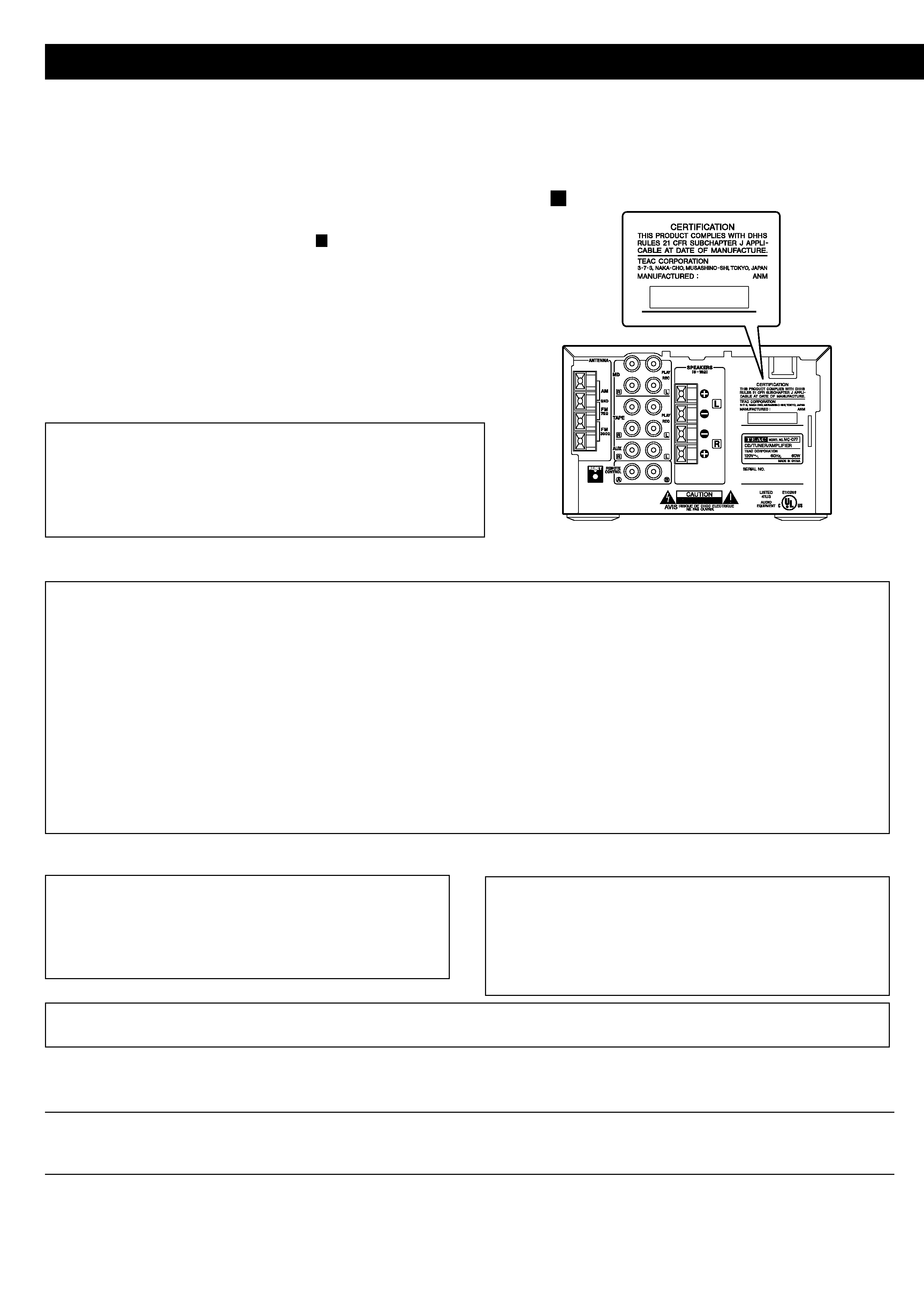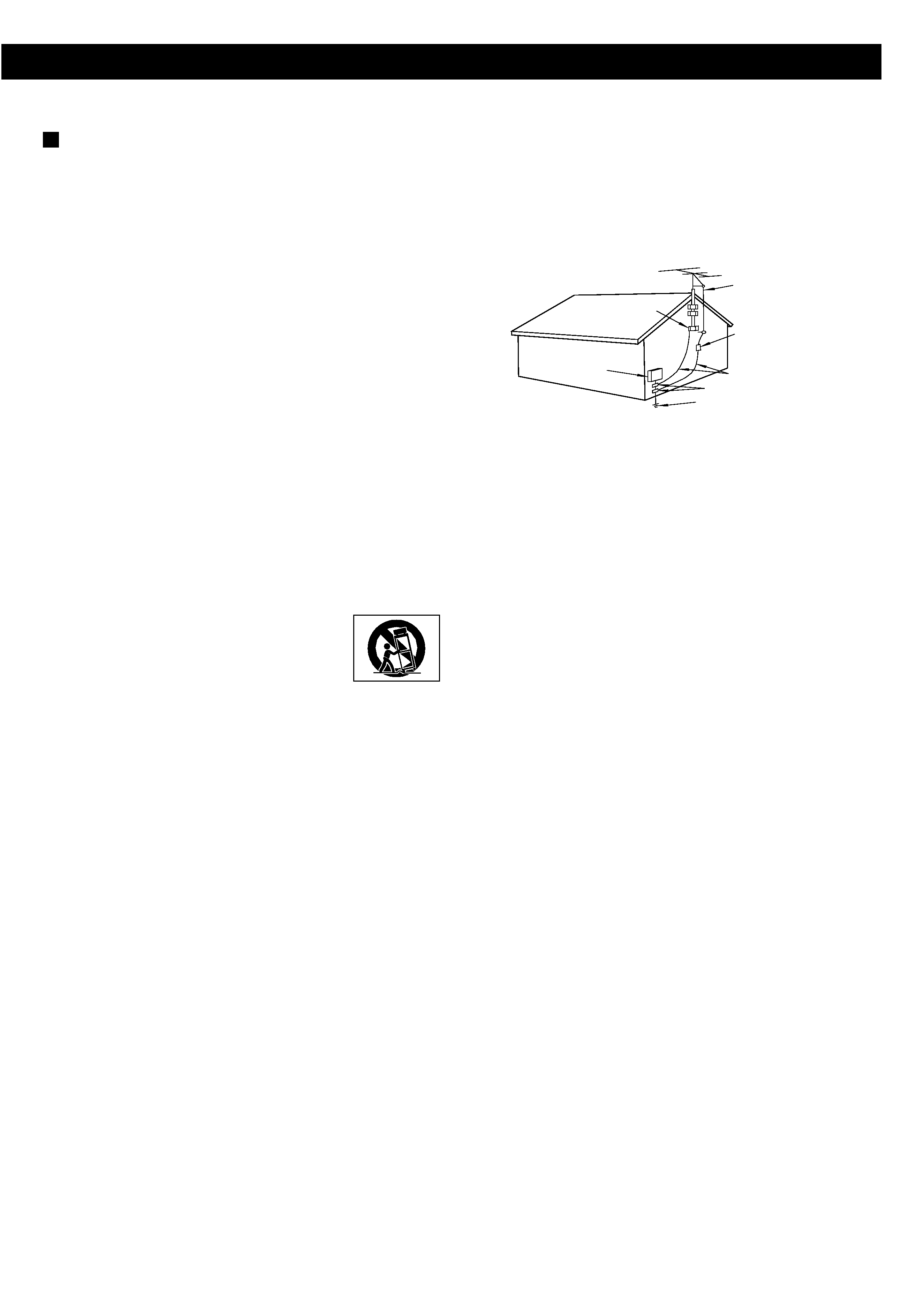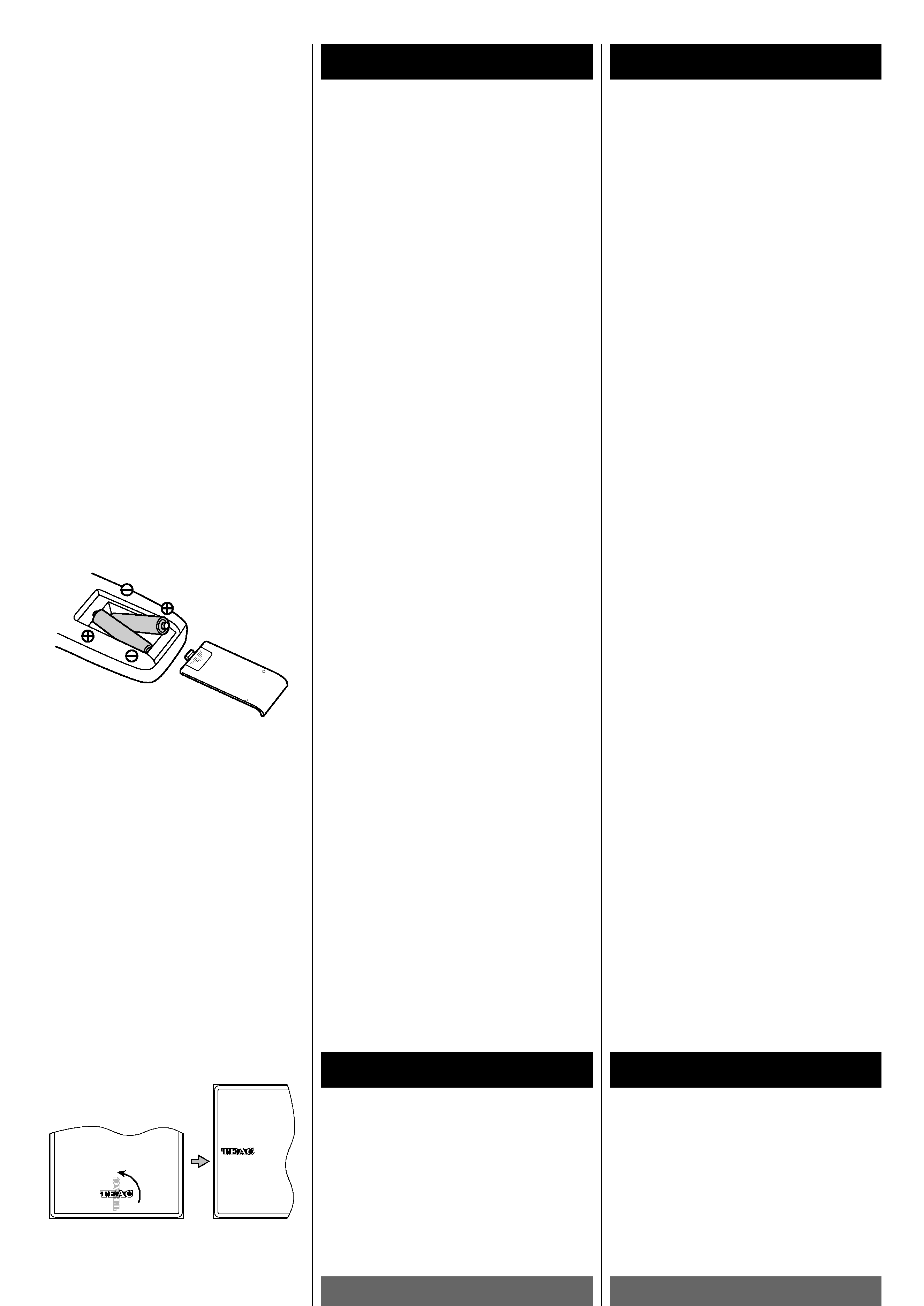
9A08752500
MC-D77
CD/Receiver Micro-System
OWNER'S MANUAL
MANUEL DU PROPRIETAIRE
Thanks for buying a TEAC. Read this manual carefully to get the best performance from this unit.
Nous vous remercions pour l'achat d'un appareil TEAC. Lire ce manuel avec attention pour
obtenir les meilleures performances possibles de cet appareil.

WARNING: TO PREVENT FIRE OR SHOCK HAZARD, DO NOT EXPOSE THIS APPLIANCE TO RAIN OR MOISTURE.
CAUTION: TO REDUCE THE RISK OF ELECTRIC SHOCK, DO NOT REMOVE COVER (OR BACK). NO USER-
SERVICEABLE PARTS INSIDE. REFER SERVICING TO QUALIFIED SERVICE PERSONNEL.
Y
E
R THE EXCLAMATION POINT WITHIN AN EQUILATERAL TRIANGLE IS INTENDED TO ALERT THE USER TO THE PRESENCE OF IMPORTANT
OPERATING AND MAINTENANCE (SERVICING) INSTRUCTIONS IN THE LITERATURE ACCOMPANYING THE APPLIANCE.
THE LIGHTNING FLASH WITH ARROWHEAD SYMBOL, WITHIN AN EQUILATERAL TRIANGLE, IS INTENDED TO ALERT THE USER TO THE
PRESENCE OF UNINSULATED "DANGEROUS VOLTAGE" WITHIN THE PRODUCT'S ENCLOSURE THAT MAY BE OF SUFFICIENT MAGNITUDE TO
CONSTITUTE A RISK OF ELECTRIC SHOCK TO PERSONS.
AC POWER CORD CONNECTION
CAUTION:
TO PREVENT ELECTRIC SHOCK, MATCH WIDE BLADE OF PLUG TO
WIDE SLOT, FULLY INSERT.
CORDE DE CONNEXION CA
ATTENTION:
POUR ÉVITER LES CHOCS ÉLECTRIQUES, INTRODUIRE LA LAME
LA PLUS LARGE DE LA
FICHE DANS LA BORNE
CORRESPONDANTE DE LA PRISE ET POUSSER JUSQU'AU FOND.
For CANADA
Pour le CANADA
Optical pickup :
Type
:
KSS-210A
Manufacturer
:
SONY Corporation
Laser output
:
Less than 0.4mW on the
objective lens
Wavelength
:
780±20 nm
For U.S.A.
1
This product has been designed and manufactured according to FDA
regulations "title 21, CFR, chapter 1, subchapter J, based on the Radiation
Control for Health and Safety Act of 1968", and is classified as class 1
laser product. There is not hazardous invisible laser radiation during
operation because invisible laser radiation emitted inside of this product
is completely confined in the protective housings.
The label required in this regulation is shown
.
CAUTION
> DO NOT REMOVE THE PROTECTIVE HOUSING USING SCREWDRIVER.
> USE OF CONTROLS OR ADJUSTMENTS OR PERFORMANCE OF
PROCEDURES OTHER THAN THOSE SPECIFIED HEREIN MAY RESULT
IN HAZARDOUS RADIATION EXPOSURE.
> IF THIS PRODUCT DEVELOPS TROUBLE, MAKE A CONTACT WITH OUR
SERVICEMAN, AND DO NOT USE THE PRODUCT IN A TROUBLED
STATE.
1
TO THE USER
This equipment has been tested and found to comply with the limits for a Class B digital device, pursuant to Part 15 of the FCC Rules. These
limits are designed to provide reasonable protection against interference in a residential area. This device generates and uses radio
frequency energy and if not installed and used in accordance with the instructions, it may cause interference to radio or TV reception. If this
unit does cause interference with TV or radio reception you can try to correct the interference by one or more of the following measures :
a) Reorient or relocate the receiving antenna.
b) Increase the separation between the equipment and the receiver.
c) Plug the equipment into a different outlet so that it is not on the same circuit as the receiver. If necessary, consult the dealer or an
experienced radio/TV technician for additional suggestions.
CAUTION
Changes or modifications to this equipment not expressly approved by TEAC CORPORATION for compliance could void the user's authority
to operate this equipment.
For U.S.A.
Important Safety Instructions
DATE CODE LABEL
2

3
CAUTION
< Read all of these Instructions.
< Save these Instructions for later use.
< Follow all Warnings and Instructions marked on the audio equipment.
1) Read Instructions -- All the safety and operating instructions should
be read before the product is operated.
2) Retain Instructions -- The safety and operating instructions should
be retained for future reference.
3) Heed Warnings -- All warnings on the product and in the operating
instructions should be adhered to.
4) Follow Instructions -- All operating and use instructions should be
followed.
5) Cleaning -- Unplug this product from the wall outlet before cleaning.
Do not use liquid cleaners or aerosol cleaners. Use a damp cloth for
cleaning.
6) Attachments -- Do not use attachments not recommended by the
product manufacturer as they may cause hazards.
7) Water and Moisture -- Do not use this product near water -- for
example, near a bath tub, wash bowl, kitchen sink, or laundry tub; in a
wet basement; or near a swimming pool; and the like.
8) Accessories -- Do not place this product on an unstable cart, stand,
tripod, bracket, or table. The product may fall, causing serious injury to
a child or adult, and serious damage to the product. Use only with a
cart, stand, tripod, bracket, or table recommended by the manufacturer,
or sold with the product. Any mounting of the product should follow the
manufacturer's instructions, and should use a mounting accessory
recommended by the manufacturer.
9) A product and cart combination should be moved
with care. Quick stops, excessive force, and uneven
surfaces may cause the product and cart combination
to overturn.
10) Ventilation -- Slots and openings in the cabinet are provided for
ventilation and to ensure reliable operation of the product and to
protect it from overheating, and these openings must not be blocked or
covered. The openings should never be blocked by placing the product
on a bed, sofa, rug, or other similar surface. This product should not be
placed in a built-in installation such as a bookcase or rack unless
proper ventilation is provided or the manufacturer's instructions have
been adhered to.
11) Power Sources -- This product should be operated only from the
type of power source indicated on the marking label. If you are not sure
of the type of power supply to your home, consult your product dealer
or local power company. For products intended to operate from battery
power, or other sources, refer to the operating instructions.
12) Grounding or Polarization -- This product may be equipped with a
polarized alternating-current line plug (a plug having one blade wider
than the other). This plug will fit into the power outlet only one way. This
is a safety feature. If you are unable to insert the plug fully into the
outlet, try reversing the plug. If the plug should still fail to fit, contact
your electrician to replace your obsolete outlet. Do not defeat the safety
purpose of the polarized plug.
13) Power-Cord Protection -- Power-supply cords should be routed so
that they are not likely to be walked on or pinched by items placed upon
or against them, paying particular attention to cords at plugs,
convenience receptacles, and the point where they exit from the
product.
14) Outdoor Antenna Grounding -- If an outside antenna or
cable
system is connected to the product, be sure the antenna or cable
system is grounded so as to provide some protection against voltage
surges and built-up static charges. Article 810 of the National Electrical
Code, ANSI/NFPA 70, provides information with regard to proper
grounding of the mast and supporting structure, grounding of the lead-
in wire to an antenna discharge unit, size of grounding conductors,
location of antenna-discharge unit, connection to grounding electrodes,
and requirements for the grounding electrode.
Note to CATV system installer:
This reminder is provided to call the CATV system installer's attention to
Section 820-40 of the NEC which provides guidelines for proper
grounding and, in particular, specifies that the cable ground shall be
connected to the grounding system of the building, as close to the point
of cable entry as practical."
15) Lightning -- For added protection for this product during a lightning
storm, or when it is left unattended and unused for long periods of time,
unplug it from the wall outlet and disconnect the antenna or cable
system. This will prevent damage to the product due to lightning and
power-line surges.
16) Power Lines -- An outside antenna system should not be located in
the vicinity of overhead power lines or other electric light or power
circuits, or where it can fall into such power lines or circuits. When
installing an outside antenna system, extreme care should be taken to
keep from touching such power lines or circuits as contact with them
might be fatal.
17) Overloading -- Do not overload wall outlets, extension cords, or
integral convenience receptacles as this can result in risk of fire or
electric shock.
18) Object and Liquid Entry -- Never push objects of any kind into this
product through openings as they may touch dangerous voltage points
or short-out parts that could result in a fire or electric shock. Never spill
liquid of any kind on the product.
19) Servicing -- Do not attempt to service this product yourself as
opening or removing covers may expose you to dangerous voltage or
other hazards. Refer all servicing to qualified service personnel.
20) Damage Requiring Service -- Unplug this product from the wall
outlet and refer servicing to qualified service personnel under the
following conditions:
a ) when the power-supply cord or plug is damaged.
b ) if liquid has been spilled, or objects have fallen into the product.
c ) if the product has been exposed to rain or water.
d) if the product does not operate normally by following the operating
instructions. Adjust only those controls that are covered by the
operating instructions as an improper adjustment of other controls may
result in damage and will often require extensive work by a qualified
technician to restore the product to its normal operation.
e) if the product has been dropped or damaged in any way.
f) when the product exhibits a distinct change in performance _ this
indicates a need for service.
21) Replacement Parts -- When replacement parts are required, be
sure the service technician has used replacement parts specified by
the manufacturer or have the same characteristics as the original part.
Unauthorized substitutions may result in fire, electric shock, or other
hazards.
22) Safety Check -- Upon completion of any service or repairs to this
product, ask the service technician to perform safety checks to
determine that the product is in proper operating condition.
23) Wall or Ceiling Mounting -- The product should be mounted to a
wall or ceiling only as recommended by the manufacturer.
24) Heat -- The product should be situated away from heat sources
such as radiators, heat registers, stoves, or other products (including
amplifiers) that produce heat.
ANTENNA
LEAD IN
WIRE
ANTENNA
DISCHARGE UNIT
(NEC SECTION 810-20)
GROUNDING CONDUCTORS
(NEC SECTION 810-21)
GROUND CLAMPS
POWER SERVICE GROUNDING
ELECTRODE SYSTEM
(NEC ART 250. PART H)
NEC - NATIONAL ELECTRICAL CODE
ELECTRIC
SERVICE
EQUIPMENT
Example of Antenna Grounding
as per National Electrical
Code, ANSI/NFPA 70
GROUND
CLAMP

ENGLISH
FRANÇAIS
4
Before Use
Avant Utilisation
Read this before operation
< Place the amplifier on a hard flat surface.
< The ventilation holes should not be
covered. Make sure there is at least 50 cm
(20 inches) of space above and at least
10cm (4 inches) of space besides the
amplifier. Do not place MD deck or other
equipment on top of the amplifier.
< Choose unit installation location carefully.
Avoid placing it in direct sunlight or close
to a source of heat. Also avoid locations
subject to vibrations and excessive dust,
heat, cold or moisture. Keep away from
sources that hum, such as transformers or
motors.
< Do not open the cabinet as this might
result in damage to the circuitry or
electrical shock. If a foreign object should
get into the set, contact your dealer.
< When removing the power plug from the
wall outlet, always pull directly on the
plug, never yank the cord.
< Do not attempt to clean the unit with
chemical solvents as this might damage
the finish. Use a clean, dry cloth.
< Keep this manual in a safe place for future
reference.
Lire ceci avant de faire fonctionner
l'appareil
< Placer l'amplificateur sur une surface
plate rigide.
< Les trous de ventilation ne doivent pas
être couverts. S'assurer qu'il y a un
espace d'au moins 50 cm au dessus et
d'au moins 10 cm à côté de l'amplificateur.
Ne pas placer un lecteur MD ou un autre
appareil sur le dessus de l'amplificateur.
< Choisir avec soin l'endroit où vous
placerez votre appareil. Eviter de le placer
directement au soleil ou près d'une
source de chaleur. Eviter aussi les
endroits sujets à des vibrations, à de la
poussière excessive, à la chaleur, au froid
ou à l'humidité. Toujours le garder éloigné
de sources de bourdonnements telles que
des transformateurs ou moteurs.
< Ne pas ouvrir le coffret car ceci risquerait
de provoquer des dommages aux circuits
ou des chocs électriques. Si un objet
rentre dans l'appareil, contacter votre
revendeur.
< Lors du débranchement du cordon
d'alimentation de la prise murale, toujours
tirer sur la fiche et non sur le cordon.
< Ne pas essayer de nettoyer l'appareil
avec des solvants chimiques car ceci
pourrait endommager le fini de l'appareil.
Utiliser un chiffon propre et sec.
< Garder soigneusement ce manuel
d'instructions pour une référence
ultérieure.
RESET Switch
In the following cases, function buttons may
not work properly.
1) When the system is damaged by some
electrical shock.
2) When the power is irregular or has
electrical noises.
In these cases, press the RESET switch once
or twice with a pencil or a ball-point pen
lightly.
*If you press this RESET switch, all the
memories will be erased. In this case, please
preset stations again.
Commutateur RESET
Dans les cas suivants, les boutons de
fonctions peuvent ne pas fonctionner
correctement
1) Quand le système est endommagé par un
choc électrique.
2) Quand l'alimentation est irrégulière ou
bruyante
Dans ces cas, appuyer la touche RESET une
ou deux fois avec un crayon ou un stylo.
Memory Backup
The typical period for which the preset
memory can be backed up while the power
cord is unplugged is about 4 weeks subject
to the surrounding environment. In case of
long hours of power failure or slipping out
of the power cord, the data may be
cleared.
Mémoire interne
Quand l'appareil n'est plus alimenté
(débranché), la mémoire(PRESET STATIONS)
interne conserve ses informations pendant
environ
4
semaines,
selon
les
circonstances. En cas de panne prolongée
ou si le cordon est accidentellement
débranché, les données risquent d'être
perdues.

5
Remote Control Unit
Télécommande
Speaker System
Système de HAUT-PARLEUR
ENGLISH
FRANÇAIS
Battery Installation
Remplacement des piles
< Si vous remarquez que la distance entre le
boîtier de télécommande et le lecteur
devient
plus
courte
pour
un
fonctionnement correct, ceci indique que
les piles sont usées. Dans ce cas,
remplacer les piles par des neuves.
Précautions à observer concernant les piles
< Bien placer les piles("AA", R6, SUM-3) en
respectant les polarités positives "+" et
négatives "_"
< Utiliser des piles du même type. Ne jamais
essayer d'utiliser des types de pile
différents ensemble.
< Des piles ou des batteries peuvent être
utilisées. Se référer à leurs étiquettes
pour les précautions à respecter.
< Si le boîtier de télécommande n'est pas
utilisé pendant une longue période (plus
d'un mois), retirer les piles du boîtier de
télécommande pour éviter des fuites de
pile. Si elles coulent, essuyer le liquide
dans le compartiment des piles et
remplacer les piles par des neuves.
< Ne pas chauffer, démonter les piles ni les
mettre au feu.
Utilisation de la télécommande
Le boîtier de télécommande fourni permet
la commande à distance de l'appareil.
Pour
l'utilisation
du
boîtier
de
télécommande, le diriger vers le détecteur
de télécommande du panneau avant de
l'appareil
Remarque:
< Même si le boîtier de télécommande est
activé dans la zone de fonctionnement, la
commande
à
distance
peut
être
impossible s'il y a des obstacles entre le
lecteur et le boîtier de télécommande.
< Si le boîtier de télécommande fonctionne
dans le voisinage d'autres appareils
générant des rayons infrarouges, ou si
d'autres télécommandes utilisant des
rayons infrarouges sont utilisées près du
lecteur, le lecteur peut ne pas bien
fonctionner. Dans la situation inverse, les
autres appareils peuvent ne pas bien
fonctionner.
Mise en place des piles
Battery Replacement
< If the distance required between the
remote control unit and main unit
decreases, the batteries are exhausted. In
this case replace the batteries with new
ones.
Precautions concerning batteries
< Be sure to insert two "AA" dry batteries
with correct positive "+" and negative
"_" polarities.
< Use batteries of the same type. Never use
different types of batteries together.
< Rechargeable and non-rechargeable
batteries can be used. Refer to the
precautions on their labels.
< When the remote control unit is not to be
used for a long time (more than a month),
remove the batteries from the remote
control unit to prevent them from leaking.
If they leak, wipe away the liquid inside
the battery compartment and replace the
batteries with new ones.
< Do not heat or disassemble batteries and
never dispose of old batteries by throwing
them in a fire.
Using the Remote Control Unit
The provided Remote Control Unit allows
the unit to be operated from a distance.
When operating the remote control unit,
point it towards the REMOTE SENSOR on
the front panel of the unit.
Notes
< Even if the remote control unit is operated
within the effective range, remote control
operation may be impossible if there are
any obstacles between the unit and the
remote control.
< If the remote control unit is operated near
other appliances which generate infrared
rays, or if other remote control devices
using infrared rays are used near the unit,
it may operate incorrectly. Conversely, the
other appliances may operate incorrectly.
L'emblem TEAC sur le pannneau avant pu
este rotatif.
Place le dans la direction qui convient
l'emplacement des haut-parleurs.
The TEAC emblem on front panel can be
rotated.
Adjust the direction to fit to your speaker
placement.
